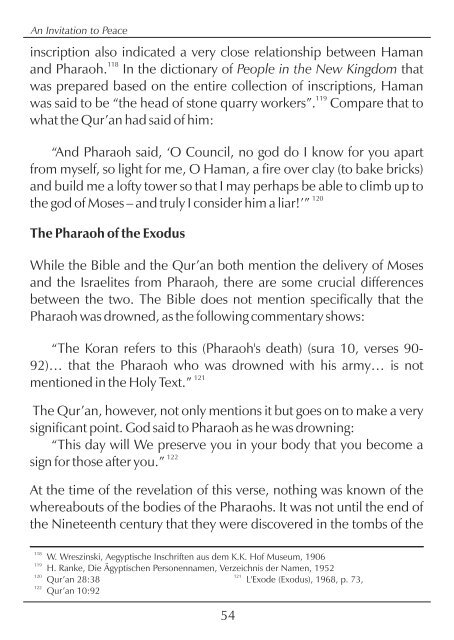An Invitation to Peace
http://www.islamicglobe.com
http://www.islamicglobe.com
You also want an ePaper? Increase the reach of your titles
YUMPU automatically turns print PDFs into web optimized ePapers that Google loves.
<strong>An</strong> <strong>Invitation</strong> <strong>to</strong> <strong>Peace</strong><br />
inscription also indicated a very close relationship between Haman<br />
118<br />
and Pharaoh. In the dictionary of People in the New Kingdom that<br />
was prepared based on the entire collection of inscriptions, Haman<br />
119<br />
was said <strong>to</strong> be “the head of s<strong>to</strong>ne quarry workers”. Compare that <strong>to</strong><br />
what the Qur’an had said of him:<br />
“<strong>An</strong>d Pharaoh said, ‘O Council, no god do I know for you apart<br />
from myself, so light for me, O Haman, a fire over clay (<strong>to</strong> bake bricks)<br />
and build me a lofty <strong>to</strong>wer so that I may perhaps be able <strong>to</strong> climb up <strong>to</strong><br />
120<br />
the god of Moses – and truly I consider him a liar!’”<br />
The Pharaoh of the Exodus<br />
While the Bible and the Qur’an both mention the delivery of Moses<br />
and the Israelites from Pharaoh, there are some crucial differences<br />
between the two. The Bible does not mention specifically that the<br />
Pharaoh was drowned, as the following commentary shows:<br />
“The Koran refers <strong>to</strong> this (Pharaoh's death) (sura 10, verses 90-<br />
92)… that the Pharaoh who was drowned with his army… is not<br />
121<br />
mentioned in the Holy Text.”<br />
The Qur’an, however, not only mentions it but goes on <strong>to</strong> make a very<br />
significant point. God said <strong>to</strong> Pharaoh as he was drowning:<br />
“This day will We preserve you in your body that you become a<br />
122<br />
sign for those after you.”<br />
At the time of the revelation of this verse, nothing was known of the<br />
whereabouts of the bodies of the Pharaohs. It was not until the end of<br />
the Nineteenth century that they were discovered in the <strong>to</strong>mbs of the<br />
118<br />
W. Wreszinski, Aegyptische Inschriften aus dem K.K. Hof Museum, 1906<br />
119<br />
H. Ranke, Die Ägyptischen Personennamen, Verzeichnis der Namen, 1952<br />
120 121<br />
Qur’an 28:38 L'Exode (Exodus), 1968, p. 73,<br />
122<br />
Qur’an 10:92<br />
54














